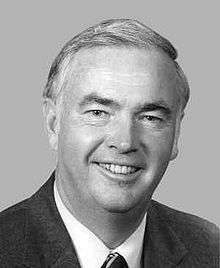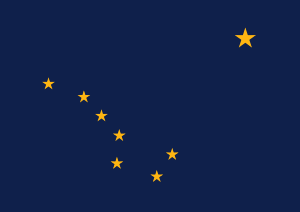Frank Murkowski
| Frank Murkowski | |
|---|---|
 | |
| 8th Governor of Alaska | |
|
In office December 2, 2002 – December 4, 2006 | |
| Lieutenant | Loren Leman |
| Preceded by | Tony Knowles |
| Succeeded by | Sarah Palin |
| United States Senator from Alaska | |
|
In office January 3, 1981 – December 2, 2002 | |
| Preceded by | Mike Gravel |
| Succeeded by | Lisa Murkowski |
| 3rd Alaska Commissioner of Economic Development | |
|
In office December 5, 1966 – December 7, 1970 | |
| Governor |
Wally Hickel Keith Miller |
| Preceded by | William Dickson |
| Succeeded by | Everett Buness |
| Personal details | |
| Born |
Frank Hughes Murkowski March 28, 1933 Seattle, Washington, U.S. |
| Political party | Republican |
| Spouse(s) | Nancy Gore (1954–present) |
| Children |
Carol Victoria Lisa Michael Francis Eileen Marie Mary Catherine Brian Patrick |
| Alma mater |
Santa Clara University Seattle University |
| Religion | Roman Catholicism |
| Military service | |
| Allegiance |
|
| Service/branch | United States Coast Guard |
| Years of service | 1955–1957 |
Frank Hughes Murkowski (/mərˈkaʊski/; born March 28, 1933) is an American politician and a member of the Republican Party. He was a United States Senator from Alaska from 1981 until 2002 and the eighth Governor of Alaska from 2002 until 2006.
Early life and career
Murkowski was born in Seattle, Washington, the son of Helen (née Hughes) and Frank M. Murkowski.[1] His paternal grandfather was of Polish descent.[2] Murkowski attended Ketchikan High School in Alaska, graduating in 1951. Studying at Santa Clara University from 1951 to 1953, he gained a BS in economics from Seattle University in 1955. Thereafter, he served in the United States Coast Guard until 1957 – the same year his daughter Lisa was born. After a stint at Pacific National Bank and further study at Pacific Coast Banking School, Murkowski became Alaska's youngest commissioner at the time when he was appointed Commissioner of Economic Development, aged 33, and was elevated to the presidency of the Alaska National Bank of the North in 1971. He has also headed the Alaska Bankers Association and – in 1977 -[3] the Alaska State Chamber of Commerce.[4]
He ran for Alaska's sole U.S. House seat in 1970, but was defeated by Democrat Nick Begich.[5]
U.S. Senate
He was first elected to the U.S. Senate in 1980, defeating Democratic candidate Clark Gruening, with the help of Ronald Reagan's popularity. He won with 54% of the vote.[5] He was re-elected in 1986, 1992, and 1998. During his time in the Senate, he was most notable as Chairman of the Energy and Natural Resources Committee from 1995 to 2001. As chair, he argued and attempted unsuccessfully to open the Arctic National Wildlife Refuge to oil drilling.
Murkowski had a pro-life record in the Senate, opposing abortion.[6] He also opposes gun control and affirmative action.[6]
In a floor statement in the Senate, regarding the ban of homosexuals serving in the military, Murkowski stated that homosexuals have a right to choose their lifestyle, but there exists no right to serve. In his opposition to lifting the ban, his speech focused on the cost effect on the Veterans Administration in treating service members infected with HIV.[7] His daughter and successor in the Senate, Lisa Murkowski, voted to repeal the ban on homosexuals in the armed services, and later became the third Republican Senator to endorse the legalization of same-sex marriage while in office.[8]
Governor
Murkowski was elected governor on November 5, 2002, receiving nearly 56% of the vote, the highest percentage for any gubernatorial candidate in Alaska history up until that point.[9] He succeeded Democrat Tony Knowles and took office on December 2, 2002.
Upon his inauguration, he resigned his Senate seat and appointed his daughter, Lisa Murkowski, the Majority Leader-designate of the Alaska House of Representatives, in his place. His opponents derided the appointment as an act of nepotism.
Toward the end of his administration he brokered a deal for a gas pipeline that was never considered, in final form, by the legislature. Murkowski threatened to sign the deal without legislative approval, but the legislature successfully brought a lawsuit to enjoin him from doing so.
Governor Murkowski ran for re-election in 2006, but came in third behind former Wasilla mayor Sarah Palin and Fairbanks businessman John Binkley in the Republican primary election on August 22, 2006 (Palin winning with 51% and Binkley taking second with 30% to Murkowski's 19%).[10] Murkowski left office with one of the nation's worst approval ratings of 19%.[11]
On March 4, 2008, Murkowski's former chief-of-staff, Jim Clark admitted that he was aware that Veco Corp had paid $10,000 for a political poll to gauge the popularity of then-incumbent Governor Murkowski. Clark was charged with "honest services fraud". Before he was sentenced, the US Supreme Court ruled that the statute was drafted with unconstitutional vagueness and henceforth will only cover "fraudulent schemes to deprive another of honest services through bribes or kickbacks supplied by a third party who ha[s] not been deceived." Since Clark was guilty of neither bribes nor kickbacks, all charges were voided.
In all 28 years of public service, Murkowski spent two years in the armed services, 22 years as Alaska's junior senator in D.C. and four years as governor.
Jet plane scandal
In 2005, in spite of opposition from the Alaska Legislature, Murkowski purchased a Westwind II jet with state money for $2.7 million.[12] This purchase became the symbol of his unpopular legacy in state politics, so much so that his successor, Sarah Palin, promised to sell the jet once she became governor.[13]
Electoral history
- United States House of Representatives election in Alaska, 1970
- Nick Begich (D), 55%
- Frank Murkowski (R), 45%
- United States Senate election in Alaska, 1980
- Frank Murkowski (R), 54%
- Clark Gruening (D), 46%
- United States Senate election in Alaska, 1986
- Frank Murkowski (R) (inc.), 54%
- Glenn Olds (D), 44%
- United States Senate election in Alaska, 1992
- Frank Murkowski (R) (inc.), 53%
- Tony Smith (D), 38%
- Mary Jordan (Grn.), 8%
- United States Senate election in Alaska, 1998
- Frank Murkowski (R) (inc.), 75%
- Joe Sonneman (D), 20%
- Alaska gubernatorial election, 2002
- Frank Murkowski (R), 56%
- Fran Ulmer (D), 41%
- Alaska gubernatorial election, 2006 (primary)
- Sarah Palin (R), 51%
- John Binkley (R), 30%
- Frank Murkowski (R) (incumbent), 19%
References
- ↑ Kestenbaum, Lawrence. "TPG: Murkowski". The Political Graveyard. Retrieved August 21, 2011.
- ↑ http://www.orbikfamily.com/murkowski/Frank-Murkowski.htm
- ↑ "Murkowski, Frank Hughes". Biographical Directory of the United States Congress. Retrieved August 21, 2011.
- ↑ "Alaska Governor Frank H. Murkowski". National Governors Association.
- 1 2 http://www.cbsnews.com/news/sen-frank-murkowski/
- 1 2 Seelye, Katharine (December 21, 2002). "New Alaska Governor Gives Daughter His Seat in Senate". New York Times. Retrieved May 10, 2015.
- ↑ "Congressional Record 103rd Congress (1993-1994) FAMILY AND MEDICAL LEAVE ACT OF 1993 (Senate – February 4, 1993)". THOMAS. Library of Congress. Retrieved June 12, 2011.
- ↑ "Senate Vote 281 – Repeals 'Don't Ask, Don't Tell'". The New York Times. December 18, 2010. Retrieved June 12, 2011.
- ↑ Fellow Republican Sean Parnell won around 59% in 2010.
- ↑ State of Alaska Division of Elections: "2006 Primary Election Results.". Retrieved March 16, 2007.
- ↑ "AK Gov". SurveyUSA. Retrieved June 20, 2010.
- ↑ Yardley, William (August 25, 2007). "Jet That Helped Defeat an Alaska Governor Is Sold". The New York Times. Retrieved April 2, 2010.
- ↑ "Governor travel shot up with Murkowski's jet, plummets with Palin". Juneau Empire. Retrieved June 20, 2010.
External links
- FrankMurkowski.com
- Biography at the Biographical Directory of the United States Congress
- Governor Murkowski rated the most unpopular governor in the entire U.S., via alaskareport.com
- Appearances on C-SPAN
| Party political offices | ||
|---|---|---|
| Preceded by C.R. Lewis |
Republican nominee for U.S. Senator from Alaska (Class 3) 1980, 1986, 1992, 1998 |
Succeeded by Lisa Murkowski |
| Preceded by John Lindauer |
Republican nominee for Governor of Alaska 2002 |
Succeeded by Sarah Palin |
| United States Senate | ||
| Preceded by Mike Gravel |
U.S. Senator (Class 3) from Alaska 1981–2002 Served alongside: Ted Stevens |
Succeeded by Lisa Murkowski |
| Preceded by Alan Simpson |
Chairperson of the Senate Veterans' Affairs Committee 1985–1987 |
Succeeded by Alan Cranston |
| Preceded by Bennett Johnston |
Chairperson of the Senate Energy Committee 1995–2001 |
Succeeded by Jeff Bingaman |
| Political offices | ||
| Preceded by Tony Knowles |
Governor of Alaska 2002–2006 |
Succeeded by Sarah Palin |


